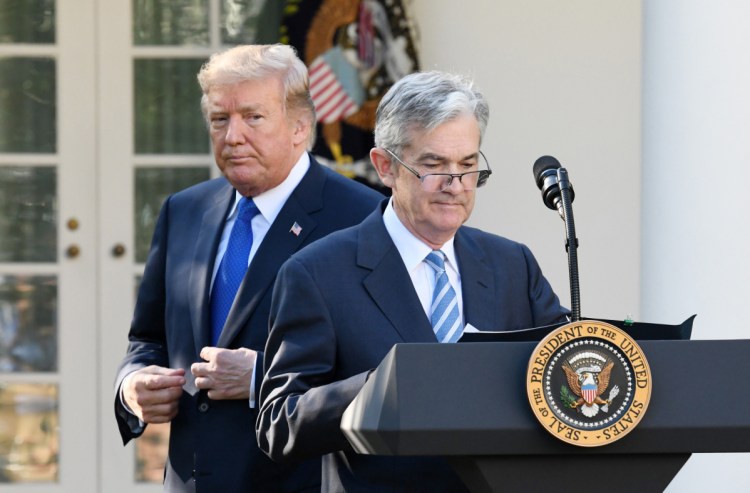WASHINGTON — Federal Reserve Chair Jerome Powell has been quietly building support on Capitol Hill to protect the central bank’s independence as President Trump has increasingly pilloried the Fed and Powell for what he calls “crazy” actions that imperil the economy.
With escalating rhetoric, Trump has said he wants to pressure Powell to keep interest rates low, breaking with years of presidential restraint in avoiding comment on Fed policy.
But while Trump has been able to rally Republicans to his cause on many issues, Powell appears to have successfully built a base of key backers on Capitol Hill. Top Republicans are supporting Powell, saying he is doing a good job in the face of withering Trump criticism.
“I believe that under Chairman Powell, the Fed is generally on the right track,” said Rep. Jeb Hensarling, R-Texas, chair of the House Financial Services Committee, which plays a critical oversight role for the Fed. “Chair Powell is the fourth Fed chair I’ve worked with. He’s probably been more forthcoming, more transparent and the most aggressive at making sure he has a healthy dialogue with key decision-makers on the Hill.”
Trump has upped his criticism in recent months as the Fed signaled it would continue its campaign of gradually increasing interest rates. The policy, long telegraphed, aims to avoid overheating in the economy, which can lead to a recession.
If Trump were able to successfully pressure the Fed into adjusting course, it could have sudden and unpredictable effects on the U.S. economy. Markets have long seen the independence of the central bank as a critical ingredient in stability, and Powell has vowed to uphold it.
Trump appointed Powell, a Republican with a history of reaching across the aisle, last year, replacing former President Barack Obama’s Fed chair, Janet Yellen. He was expected to continue Yellen’s course of gradual interest rate hikes, a long process of normalization since the Fed brought rates to zero during the 2008 financial crisis.
Powell’s first big challenge hasn’t been policy or a financial crisis, but an unpredictable president.
Behind the scenes, Powell has been increasing transparency at the bank and forging deep alliances with Congress, moves that have helped keep a wide base of support for the Fed as Trump goes on the attack.
Powell’s outreach strategy began long before Trump started blasting him over the summer. A few days before he was sworn in as Fed chair in early February, Powell traveled to the Republicans’ House Financial Services Committee retreat in Maryland. Republican lawmakers recall the meeting as engaging and candid about the economy and regulations.
Republicans say Powell’s predecessors, Yellen and Ben Bernanke, often gave long, professor-like answers to questions that left lawmakers unclear where top Fed officials stood. They prefer Powell’s “plain English” responses.
“I’m on my third Federal Reserve chair. Chairman Powell has been the most accessible, most open Federal Reserve chair that I have seen,” said Rep. Steve Stivers, R-Ohio, a member of the House Financial Services Committee.
Powell has continued to wear out the carpets on Capitol Hill, making 60 one-on-one visits and calls with lawmakers of both parties, according to his public calendars from February to August (the latest available). Some say Powell is the easiest Fed chair to deal with since Alan Greenspan, who was famed for his skill at navigating Washington’s political scene.
Many Republicans have bucked the president and voiced their support for Powell and the Fed’s current plan of gradually raising interest rates. Orrin Hatch, chair of the Senate Finance Committee, said Wednesday he thought Powell was doing a good job, adding that there are “pretty good people” at the Fed right now.
Trump’s main criticism is that the Fed’s interest rate increases will slow economic growth and cause some people to lose their jobs. Powell argues that the economy is strong and interest rates need to return to a more normal level – around 3 percent – that won’t cause the economy to overheat. The Fed last hiked interest rates in September to a range of 2 percent to 2.25 percent, which is still low by historical standards.
“We’re working hard to try to sustain the expansion and keep unemployment low and inflation right on target,” Powell said at his last public appearance Oct. 3. “There’s no reason to think this cycle can’t continue for some time, effectively indefinitely.”
For now, the economy is showing a lot of signs of strength, and few in Congress see the Trump versus Powell standoff as a pressing issue. But that could change if the economy softens or if Powell doesn’t go as far as Republicans want on scaling back what they see as onerous regulations on banks.
Send questions/comments to the editors.



Comments are no longer available on this story